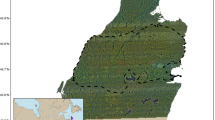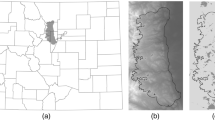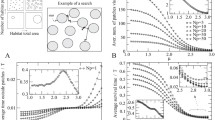Abstract
Metapopulation and optimal foraging theories predict the presence of animals and their duration, respectively, in foraging patches. This paper examines use of these two theories to describe the movements and patterns of foraging in patches used by Caspian gulls (Larus cachinnans) at inland reservoirs during the chick-rearing period. We assumed that birds would move differently across diverse habitats, with some types of land cover less permeable than others, and some landscape features acting as corridors. We also expected larger and less isolated patches, and patches that were close to corridors, to have a higher probability of the presence of foraging birds, and that they would be more abundant, forage for a shorter time, and hunt smaller prey than in small, more isolated patches surrounded by barriers. Forests seem to be a much less permeable type of land cover, whereas rivers became corridors for Caspian gulls during foraging trips. Probability of bird presence was positively related to the size of foraging patches and negatively linked with distance to the nearest river, distance to the nearest foraging patch, and the presence of forests in the vicinity. The same factors significantly affected bird abundance. Contrary to expectations, the duration and success of foraging were not influenced by any variable we measured, suggesting that although larger patches contain a higher abundance of fish, their density and the probability of capturing prey were relatively stable among the various patches. However, gulls that foraged in more isolated ponds that were located further from the river and the colony, and also surrounded by forest, captured larger fish more often than birds that foraged near the colony in less-isolated patches. Pooling metapopulation and optimal foraging concepts seems to be valuable in describing patch use by foraging animals.



Similar content being viewed by others
References
Aars J, Ims RA (1999) The effect of habitat corridors on rates of transfer and interbreeding between vole demes. Ecology 80:1648–1655
Beier P, Noss RF (1998) Do habitat corridors provide connectivity? Conserv Biol 12:1241–1252. doi:10.1046/j.1523-1739.1998.98036.x
Bélisle M, St Clair CC (2001) Cumulative effects of barriers on the movement of forest birds. Conserv Ecol 5(2): 9 [online] URL: http://www.consecol.org/vol5/iss2/art9
Bhattacharya M, Primack RB, Gerwein J (2003) Are roads and railroads barriers to bumblebee movement in a temperate suburban conservation area? Biol Conserv 109:37–45
Block BA, Dewar H, Blackwell SB, Williams TD, Price ED, Farwell CJ, Boustany A, Teo SLH, Seitz A, Walli A, Fudge D (2001) Migratory movements, depth preferences, and thermal biology of Atlantic bluefin tuna. Science 293:1310–1314
Bolen EG, Robinson WL (1995) Wildlife ecology and management, 3rd edn. Prentice Hall, Englewood Cliffs
Bukacińska M, Bukaciński D, Spaans AL (1996) Attendance and diet in relation to breeding success in herring gulls (Larus argentatus). Auk 113:300–309
Conradt L, Roper TJ (2006) Nonrandom movement behavior at habitat boundaries in two butterfly species: implications for dispersal. Ecology 87:125–132
Conradt L, Bodsworth EJ, Roper TJ, Thomas CD (2000) Non-random dispersal in the butterfly Maniola jurtina: implications for metapopulation models. Proc R Soc B 267:1505–1510
Cresswell JE, Osborne JL (2004) The effect of patch size and separation on bumblebee foraging in oilseed rape: implications for gene flow. J Appl Ecol 41:539–546
Desrochers A, Hannon SJ (1997) Gap crossing decisions by forest songbirds during the post-fledging period. Conserv Biol 11:1204–1210
Dobrowolski KA (1995) Environmental—economic evaluation of fish ponds in Poland. IUCN Poland, Warszawa
Dramstad WE, Fry GLA, Schaffer MJ (2003) Bumblebee foraging—is closer really better? Agric Ecosyst Environ 95:349–357. doi:10.1016/S0167-8809(02)00043-9
Dunning JB Jr, Borgella RJ, Clements K, Meffe GK (1995) Patch isolation, corridor effects, and colonization by a resident sparrow in a managed pine woodlot. Conserv Biol 9:542–550
Ellner SP, McCauley E, Kendall B, Briggs CJ, Hosseini PR, Wood S, Janssen A, Sabelis MW, Turchin P, Nisbet RM, Murdoch WW (2001) Habitat structure and population persistence in an experimental community. Nature 412:538–543
Faber M, Betleja J, Malczyk P, Gwiazda R (2001) Mixed colonies of large white-headed gulls in southern Poland. Br Birds 94:529–534
Giraldeau L-A, Kramer DL (1982) The marginal value theorem: a quantitative test using load size variation in a central place forager, the eastern chipmunk, Tamias striatus. Anim Behav 30:1036–1042
Guadagnin D, Maltchik L (2007) Habitat and landscape factors associated with neotropical waterbird occurrence and richness in wetland fragments. Biodivers Conserv 16:1231–1244
Gwiazda R (2004) Fish in the food of the cormorant and yellow-legged gull in the breeding sites near ponds (Upper Vistula River valley, southern Poland). Acta Zool Cracov 47:17–26
Haas CA (1995) Dispersal and use of corridors by birds in wooded patches on an agricultural landscape. Conserv Biol 9:845–854
Harris RJ, Reed MJ (2002) Behavioral barriers to non-migratory movements in birds. Ann Zool Fenn 39:275–290
Harris LD, Scheck J (1991) From implications to applications: the dispersal corridor principle applied to the conservation of biological diversity. In: Saunders DA, Hobbs RJ (eds) Nature conservation 2: the role of corridors. Surrey Beaty and Sons, Chipping Norton, pp 189–220
Heinz SK, Strand E (2006) Adaptive patch searching strategies in fragmented landscapes. Evol Ecol 20:113–130. doi:10.1007/s10682-005-5378-y
Jonsen ID, Myers RA, Flemming JM (2003) Meta-analysis of animal movement using state-space models. Ecology 84:3055–3063. doi:10.1890/02-0670
Jonsson L (1998) Yellow-legged gulls and yellow-legged herring gulls in the Baltic. Alula 3:74–100
Kacelnik A (1984) Central place foraging in starlings (Sturnus vulgaris). I. Patch residence time. J Anim Ecol 53:283–299. doi:10.2307/4357
Kareiva PM (1990) Population dynamics in spatially complex environments: theory and data. Philos T Roy Soc B 330:175–190
Klaassen RHG, Nolet BA, Van Leeuwen CHA (2007) Prior knowledge about spatial pattern affects patch assessment rather than movement between patches in tactile-feeding mallard. J Anim Ecol 76:20–29
Kramer DL (2001) Foraging behavior. In: Fox CW, Roff DA, Fairbairn DJ (eds) Evolutionary ecology: concepts and case studies. Oxford University Press, New York, pp 232–246
Lair H, Kramer DL, Giraldeau L-A (1994) Interference competition in central place foragers: the effect of imposed waiting on patch use decisions of eastern chipmunks. Behav Ecol 5:237–244
Lens L, Dhondt AA (1994) Effects of habitat fragmentation on the timing of crested tit Parus cristatus natal dispersal. Ibis 136:147–152
Lesaffre E, Mrax B (1993) Collinearity in generalized linear regression. Commun Stat-Theor M 22:1933–1952
MacMahon JA, Holl KD (2001) Ecological restoration: a key to conservation biology’s future. In: Soule ME, Orians GH (eds) Conservation biology–research priorities for the next decade. Island Press, Washington, pp 245–269
Marciniak B, Nadolski J, Nowakowska M, Loga B, Banbura J (2007) Habitat and annual variation in arthropod abundance affects blue tit Cyanistes caeruleus reproduction. Acta Ornithol 42:53–62
Matthysen E, Currie D (1996) Habitat fragmentation reduces disperser success in juvenile nuthatches Sitta europaea: evidence from patterns of territory establishment. Ecography 19:67–72
Matthysen E, Adreaensen F, Dhondt AA (1995) Dispersal distances of nuthatches, Sitta europaea, in a highly fragmented forest habitat. Oikos 72:375–381
Mech SG, Hallett JG (2001) Evaluating the effectiveness of corridors: a genetic approach. Conserv Biol 15:467–474
Menard S (2000) Coefficients of determination for multiple logistic regression analysis. Am Stat 54:17–24. doi:10.2307/2685605
Merckx T, Van Dyck H (2007) Habitat fragmentation affects habitat-finding ability of the speckled wood butterfly, Pararge aegeria L. Anim Behav 74:1029–1037. doi:10.1016/j.anbehav.2006.12.020
Merriam G (1991) Corridors and connectivity: animal populations in heterogeneous environments. In: Saunders DA, Hobbs RJ (eds) Nature conservation 2: the role of corridors. Surrey Beaty and Sons, Chipping Norton, pp 133–142
Moilanen A, Hanski I (1998) Metapopulation dynamics: effects of habitat patch area and isolation, habitat quality and landscape structure. Ecology 79:2503–2515
Perault DR, Lomolino MV (2000) Corridors and mammal community structure across a fragmented, oldgrowth forest landscape. Ecol Monogr 70:401–422
Quinn GP, Keough MJ (2002) Experimental design and data analysis for biologists. Cambridge University Press, Cambridge
Riegert J, Fainova D, Mikes V, Fuchs R (2007) How urban Kestrels Falco tinninculus divide their hunting grounds: partitioning or cohabitation? Acta Ornithol 42:69–76
Ries L, Debinski DM (2001) Butterflies responses to habitat edges in the highly fragmented prairies of Central Iowa. J Anim Ecol 70:840–852
Rosenberg DK, Noon BR, Meslow EC (1997) Biological corridors: form, function, and efficacy. Bioscience 47:677–687
Schwemmer P, Garthe S (2006) Spatial patterns in at-sea behaviour during spring migration by little gulls (Larus minutus) in the south-eastern North Sea. J Ornithol 147:354–366
Schwemmer P, Garthe S, Mundry R (2008) Area utilization of gulls in a coastal farmland landscape: habitat mosaic supports niche segregation of opportunistic species. Landscape Ecol 23:355–367
Shipley LA, Spalinger DE (1995) Influence of size and density of browse patches on intake rates and foraging decisions of young moose and white-tailed deer. Oecologia 104:112–121
Shultz CB, Crone EE (2001) Edge-mediated dispersal behaviour in a prairie butterfly. Ecology 82:1879–1892
Skórka P, Wójcik JD (2008) Habitat utilisation, feeding tactics and age related feeding efficiency in the Caspian Gull Larus cachinnans. J Ornithol 149:31–39. doi:10.1007/s10336-007-0208-3
Skórka P, Wójcik JD, Martyka R (2005) Colonization and population growth of yellow-legged gull Larus cachinnans in south-eastern Poland: causes and influence on native species. Ibis 147:471–482
Skórka P, Martyka R, Wójcik JD (2006) Species richness of breeding birds at a landscape scale—which habitat type is the most important? Acta Ornithol 41:49–54
St Clair CC, Bélisle M, Desrochers A, Hannon SJ (1998) Winter response of forest birds to habitat corridors and gaps. Conserv Ecol 2(2):13 [online] URL: http://www.consecol.org/vol2/iss2/art13
Stamps JA, Buechner M, Krishnan VV (1987) The effects of edge permeability and habitat geometry on emigration from patches of habitat. Am Nat 129:533–552
Turchin P (1998) Quantitative analysis of movement and spatial population dynamics. Wiley, New York
Weimerskirch H, Gault A, Cherel Y (2005) Prey distribution and patchiness: factors in foraging success and efficiency of wandering albatrosses. Ecology 86:2611–2622
Acknowledgments
We are grateful to Siva Jayaprakash and three anonymous referees for their critical comments on previous versions of the manuscript. We thank all field assistants for their help with this study. Special thanks to J. Skorka for his enormous help in 2002. This study was partially financed by project NN304 2370 33 from the Polish Ministry of Science and Higher Education. PS was the beneficiary of a Grant for Young Scientists of the Foundation for Polish Science.
Author information
Authors and Affiliations
Corresponding author
Electronic supplementary material
Below is the link to the electronic supplementary material.
Rights and permissions
About this article
Cite this article
Skórka, P., Lenda, M., Martyka, R. et al. The use of metapopulation and optimal foraging theories to predict movement and foraging decisions of mobile animals in heterogeneous landscapes. Landscape Ecol 24, 599–609 (2009). https://doi.org/10.1007/s10980-009-9333-0
Received:
Accepted:
Published:
Issue Date:
DOI: https://doi.org/10.1007/s10980-009-9333-0




